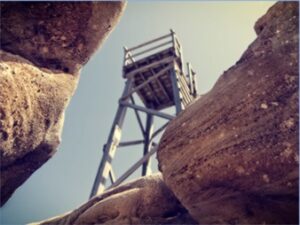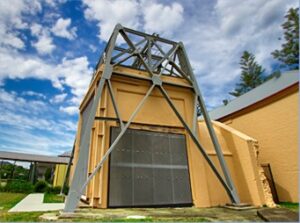
Redhead Men’s Shed Incorporated
ABN 19855272328
PO Box 7001
Redhead NSW 2290

Menu

Redhead Men’s Shed Incorporated
ABN 19855272328
PO Box 7001
Redhead NSW 2290

This space was the first upcast shaft (steam powered) winder house built in the period 1892-1893 when the colliery was developed as Durham Colliery. Even though the steam winder was replaced by an electrical winder in the mid 1930s, (housed in an adjoining annexe located to the immediate south and demolished in 1994) reportedly the steam winder remained until the early 1950s after which time the space was enlarged to include a lecture room, store and surveyor’s drawing office.
This biggish space was the first boiler house for the Upcast Shaft. It also dates from the Durham Colliery era of 1892-1893. Steam was provided by two Lancashire boilers. In about 1910 a new boiler house was erected east of the original. In 1923 the first boiler house was marked as a store. The interior view provides a fine angle to view the distinctive and industrial-trend setting round –arched cast iron windows. Externally these windows complement the brick panels, plinths and ventilated friezes. This design was selected by Thomas Croudace as the best from British Colliery design of the late 19th century. Where else can this architecture be seen in Australia? Interestingly when BHP developed John Darling Colliery in the 1920s the buildings incorporated this style of window.
This shaft is the reason for the other buildings. It is an industrial and engineering gem.
This group consists of a shaft, headframe, access chamber, fan housing and engine room for the fan. Work on the sinking of this shaft commenced in 1888 and finished in 1890. Because of the sand and generally soft material encountered in the early sinking efforts Tubbing was used to a depth of about 21 metres (70 feet) until solid rock was encountered. Depth of shaft is about 133 metres. Tubbing consists of flanged, stiffened and bolted plates of curved cast iron. This shaft is probably the only point in Australia where this ingenious 19th engineering application can be seen.
Initially a timber headframe was constructed above this shaft as a means of entry and egress. The metal one probably dates from the mid 1930s following acquisition of the colliery by BHP. The timber bases of the 1890s headframe can still be seen.
By January 1893 a 13 metre (42 feet) diameter Waddle fan, the largest in the Newcastle Coalfield had been installed at Durham Colliery. Such a large fan was installed partly in response to two methane gas ignitions and explosions. The flanges and attachment points for the Waddle fan can still be seen. Over time no less than four different fans have operated in conjunction with the upcast shaft.
The large building to the south of the upcast shaft is the independent engine house powering the Waddle fan. It apparently operated until the Scottish Australian Mining Company closed the colliery in 1928. Following BHP ownership electrical power was supplied from John Darling Colliery at Belmont North and the fan engine house became an electrical switch room.
Conservation Study of Lambton Colliery. Irving & Pratten. 1992.
Also LMCC prepared a tan, light brown covered booklet.
Doring C & MJ “Statement of Evidence of Carl Doring and Margaret Doring in the Matter of the City of Lake Macquarie –v- FAI Mining Ltd in the NSW Land and Environment Court” December, 1992.
Tonks, Ed “Adamstown via Fernleigh – Trains and Collieries of the Belmont Line” NSW RTM 1988.
Tonks, Ed “Lambton by the Sea – The last 19th Century Colliery on the Newcastle Coalfield” Headframe Publishing 1995.